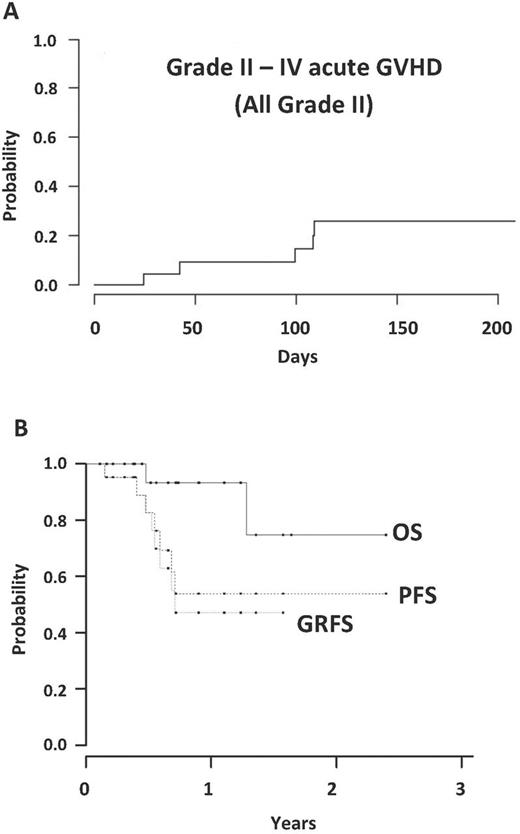Abstract

Introduction: NMA haplo BMT with high-dose post-transplantation cyclophosphamide (PTCy) is an increasingly popular strategy for patients (pts) without matched donors. However, some pts in need of BMT lack suitable first-degree related haplo donors. Outcomes using related donors other than first-degree relatives are unknown.
Methods: We prospectively evaluated 22 consecutive adult pts with hematologic malignancies who underwent NMA haplo BMT at Johns Hopkins using second- or third- degree related donors. All pts received NMA conditioning with fludarabine (30 mg/m2 IV days -6 to -2), Cy (14.5 mg/kg IV days -6 and -5), and TBI (200 cGy day -1), followed by T-cell replete allografting (86% bone marrow, 14% peripheral blood). Graft-versus-host disease (GVHD) prophylaxis consisted of high-dose PTCy (50 mg/kg IV on days 3 and 4), mycophenolate mofetil on days 5-35, and either sirolimus (14 pts) or tacrolimus (8 pts) from days 5-180. GCSF was given from day 5 until ANC ≥1000/µL. Thirteen grafts (59%) were matched at 5/10 HLA alleles, while 9 (41%) were matched at >5 but <10 alleles.
Results: The median pt age was 52 (range 25-73) years. Donors (median age 34 years, range 13-69) consisted of 7 nieces (32%), 6 first cousins (27%), 5 nephews (23%), 2 grandchildren (9%), and 2 uncles (9%). The indications for BMT were AML in 11 pts (50%), ALL in 7 (32%), NHL in 2 (9%), MDS in 1 (5%), and aplastic anemia in 1 (5%). At time of BMT, 19 pts (86%) were in CR. Twenty pts (91%) reached full donor chimerism by day 60. Three pts (14%) developed graft failure (1 primary, 2 secondary), with recovery of autologous hematopoiesis in all cases. The median times to neutrophil recovery and platelet recovery (>20,000/mL) were 18 days and 25 days, respectively. On competing-risk analysis, the cumulative incidence (CuI) of grade II-IV acute GVHD (aGVHD) at day 100 was 15% (90% CI: 1-28%) and at day 180 was 26% (90%CI: 9-43%)(Figure A). No pts experienced grade III-IV aGVHD. Of the 5 pts with grade II aGVHD, 3 had skin and ungradable visceral involvement, while 2 had skin involvement only. At 1 year, the CuI of any chronic GVHD was 13% (90% CI: 0-28%), and the CuI of immunosuppression use for GVHD was 20% (90% CI: 5-36%). The CuI of nonrelapse mortality (NRM) was 6% at 1 year (90%CI: 0-17%), with 1 nonrelapse death from sepsis. With a median follow up of 8.6 months, the 1-year probability of GVHD-free, relapse-free survival (GRFS) was 47% (90% CI, 30-75%). At 1 year, the probability of relapse was 40% (90% CI: 17-62%), progression-free survival (PFS) was 54% (90% CI: 36-81%) and overall survival (OS) was 93% (90% CI: 83-100%)(Figure B).
Discussion: These results demonstrate the safety of NMA, T-cell replete haplo BMT with PTCy using second-degree and third-degree related donors. Survival, NRM, and GVHD outcomes are comparable to published outcomes following matched or haplo first-degree related BMT with PTCy. With this transplantation platform, non-first-degree, haplo relatives are a viable alternative donor source for pts in need of BMT.
Varadhan: PCORI: Research Funding. Jones: BioTheryX: Research Funding.
Author notes
Asterisk with author names denotes non-ASH members.

This icon denotes a clinically relevant abstract


